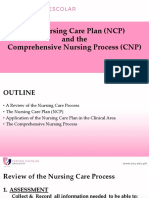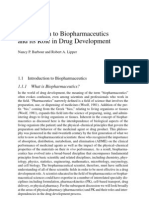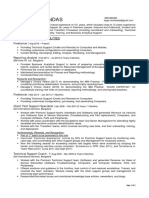1B0DC46B-2D56-474B-81B5-AF1D9FA68F2F
1B0DC46B-2D56-474B-81B5-AF1D9FA68F2F
Uploaded by
JoelynMacalintalCopyright:
Available Formats
1B0DC46B-2D56-474B-81B5-AF1D9FA68F2F
1B0DC46B-2D56-474B-81B5-AF1D9FA68F2F
Uploaded by
JoelynMacalintalCopyright
Available Formats
Share this document
Did you find this document useful?
Is this content inappropriate?
Copyright:
Available Formats
1B0DC46B-2D56-474B-81B5-AF1D9FA68F2F
1B0DC46B-2D56-474B-81B5-AF1D9FA68F2F
Uploaded by
JoelynMacalintalCopyright:
Available Formats
MACALINTAL, JOELYN M.
What is Pharmacology? It’s significance to the nursing profession?
Pharmacology is the study of chemicals-drugs-on living tissues and how these chemicals help diagnose,
treat, cure, and prevent disease or correct the pathophysiology of living tissues.
As nurses play an integral role in the administration of medication, they should have a good
understanding of pharmacology. Having this knowledge is very important to prevent possible fatal drug
interactions.
How did Pharmacology started?
The turn of the century denoted the origin of pharmacology as a logical discipline in the US. The main
seat in pharmacology in this nation was set up in 1890 at the College of Michigan by John Jacob Abel
who had prepared under Schmiedeberg.
Define the different drug names
There are 3 types of names for drugs: chemical names, generic or nonproprietary names, and trade
names which are brand name.
What are the different drug preparations? What are the nursing considerations before and after administration?
Preparation:
Liquid: The active part of the medicine is combined with a liquid to make it easier to take or better
absorbed. A liquid may also be called a ‘mixture’, ‘solution’ or ‘syrup’. Many common liquids are now
available without any added coloring or sugar.
Tablet: The active ingredient is combined with another substance and pressed into a round or oval solid
shape. There are different types of tablet. Soluble or dispersible tablets can safely be dissolved in water.
Capsules: The active part of the medicine is contained inside a plastic shell that dissolves slowly in the
stomach. You can take some capsules apart and mix the contents with your child’s favorite food. Others
need to be swallowed whole, so the medicine isn’t absorbed until the stomach acid breaks down the
capsule shell.
https://www.gosh.nhs.uk/conditions-and-treatments/medicines-information/types-medicines/
Consideration BEFORE administration:
Verify any medication order and make sure it’s complete. The order should include the drug name,
dosage, frequency and route of administration. If any element is missing, check with the practitioner.
Check the patient's medical record for an allergy or contraindication to the prescribed medication. If an
allergy or contraindications exist, don't administer the medication and notify the practitioner.
Prepare medications for one patient at a time.
Educate patients about their medications. Encourage them to speak up if something seems amiss.
Follow the eight rights of medication administration.
https://www.nursingcenter.com/ncblog/may-2016/medication-safety-go-beyond-the-basics
Consideration AFTER administration
Educate client about medications
Educate client on medication self-administration procedures
Prepare and administer medications, using rights of medication administration
Review pertinent data prior to medication administration (e.g., contraindications, lab results, allergies,
potential interactions)
Mix medications from two vials when necessary (e.g., insulin)
Administer and document medications given by common routes (e.g., oral, topical)
Administer and document medications given by parenteral routes (e.g., intravenous, intramuscular,
subcutaneous)
Participate in medication reconciliation process
Titrate dosage of medication based on assessment and ordered parameters (e.g., giving insulin
according to blood glucose levels, titrating medication to maintain a specific blood pressure)
Dispose of unused medications according to facility/agency policy
Evaluate appropriateness and accuracy of medication order for client
https://www.registerednursing.org/nclex/medication-administration/
Doctor’s order:
Give Furosemide (Lasix) 40 mg. IV now, then 20 mg IV q 8 hrs. To patients with heart failure. The ampule
contains 10 mg/ml for a total of 2 ml/ ampule.
How many ml will the nurse aspirate and how many ampules will he/she open?
Ml will the nurse aspirate
10 mg/ 1 ml = 20 mg/ 2ml/ampule
40 mg + 20 + 20 + 20 q 8 hrs. = 100 mg
100 mg/ (x) 10 ml = 20 mg/2ml
Final Answer: 10 ml
Ampules will he/she open
2 ml/ 1 ampule = 10 ml/ (x) 5 ampules
Final Answer: 5 ampules
What are your considerations before you administer Furosemide?
Furosemide is often given in conjunction with a potassium supplement or a potassium-sparing diuretic to
counteract potassium loss.
The medication has a rapid onset of effect of about one hour when taken orally and five minutes by injection.
Duration of action is about six hours so it is possible to use a twice daily dose if necessary.
In a given order, what is the generic name, the brand name, dosage, and route of administration?
Generic name: Furosemide
Brand name: Lasix
Dosage: 10mg/ml
Route of administration: Generally, Furosemide should be administered intravenously. Intramuscular
administration must be restricted to exceptional cases where neither oral nor intravenous administration is
feasible. It must be noted that intramuscular injection is not suitable for the treatment of acute conditions such
as pulmonary edema.
You might also like
- Jeddah Zoning and Building PermitsDocument5 pagesJeddah Zoning and Building PermitsCmc lebNo ratings yet
- Maternal TransesDocument14 pagesMaternal TransesRhizel Marie Cauilan FariñasNo ratings yet
- Patophy of PudDocument4 pagesPatophy of PudClarence BravioNo ratings yet
- Community Health Nursing ProcessDocument15 pagesCommunity Health Nursing ProcessLheane Marley LopenaNo ratings yet
- CDX 1 FinalDocument74 pagesCDX 1 FinalGabby Elardo100% (1)
- PersonalityDocument1 pagePersonalityJrBong SemaneroNo ratings yet
- Chapter 017Document17 pagesChapter 017MuhTaswinTachir100% (1)
- Aan 202 CourseworkDocument17 pagesAan 202 CourseworkCris GalendezNo ratings yet
- Alc Intra1 Questionnaire HypertensiveDocument5 pagesAlc Intra1 Questionnaire HypertensiveAndrea Blanca100% (1)
- An Insight Into Plants Vol 3 Excerpts PDFDocument41 pagesAn Insight Into Plants Vol 3 Excerpts PDFcausmicdance0% (3)
- Tapping Solution e BookDocument25 pagesTapping Solution e BookJessica King92% (13)
- Course Task 1: Kapoor Amrit Kaur C. Bsn2-A-9 Sep 13 2021Document3 pagesCourse Task 1: Kapoor Amrit Kaur C. Bsn2-A-9 Sep 13 2021Katrina Aballa100% (1)
- Challenges To Implementation of The Pharmaceutical Care Practice in Davao City.Document11 pagesChallenges To Implementation of The Pharmaceutical Care Practice in Davao City.JessieLynMolinaNo ratings yet
- Nursing Care Plan Acute Lymphoblastic LeukemiaDocument2 pagesNursing Care Plan Acute Lymphoblastic LeukemiabluennaNo ratings yet
- A Drug Study On FansidarDocument7 pagesA Drug Study On FansidarCasey EmellanoNo ratings yet
- RRL 8 Part 3Document55 pagesRRL 8 Part 3Joshua Christian Gan0% (1)
- ReflectionDocument3 pagesReflectionmbhakta123No ratings yet
- MeaslesDocument7 pagesMeaslesKarl FloresNo ratings yet
- Reflection Paper Pediatric Community-Acquired Pneumonia in The United StatesDocument2 pagesReflection Paper Pediatric Community-Acquired Pneumonia in The United StatesLecery Sophia WongNo ratings yet
- CHNDocument34 pagesCHNCatherine RomeroNo ratings yet
- NCMA 219 RUBRICS Administering Blood TransfusionDocument2 pagesNCMA 219 RUBRICS Administering Blood Transfusioncaitie miracleNo ratings yet
- Health History Format BlankDocument32 pagesHealth History Format BlankRich-Anne LagarasNo ratings yet
- Ocne Competencies Updated 3 11 15Document8 pagesOcne Competencies Updated 3 11 15api-255767391No ratings yet
- Community Rotation ReflectionDocument4 pagesCommunity Rotation Reflectionapi-296539974100% (1)
- Case Study FormatDocument5 pagesCase Study FormatEden OlasabNo ratings yet
- FNCPDocument7 pagesFNCPMaria Ivy Rochelle TanNo ratings yet
- HTN Urgency Case StudyDocument4 pagesHTN Urgency Case StudyJavin TNo ratings yet
- Health Systems Supplemental Notes For Module 3Document6 pagesHealth Systems Supplemental Notes For Module 3CHARLES RONALD GENATONo ratings yet
- I Will Avoid Taking This Medication With Orange Juice.Document7 pagesI Will Avoid Taking This Medication With Orange Juice.jose godfreycNo ratings yet
- Lack of Patient CounselingDocument15 pagesLack of Patient CounselingAzan AhmadNo ratings yet
- Attapulgite PDFDocument1 pageAttapulgite PDFWindy Tonapa100% (1)
- Module 2 National Immunization Program (Npi) - MihpDocument15 pagesModule 2 National Immunization Program (Npi) - MihpNurhaifa Mocadema100% (1)
- Case Analysis CHN2Document3 pagesCase Analysis CHN2Nicxx Gaming100% (1)
- ValeraJMP ACT3Document6 pagesValeraJMP ACT3JMICHELLE VALERANo ratings yet
- Cruzada, Marjorie J. NCM 107-Care of Mother, Child and Adolescent Define or Give Brief Description For Each of The Obstetric TermsDocument6 pagesCruzada, Marjorie J. NCM 107-Care of Mother, Child and Adolescent Define or Give Brief Description For Each of The Obstetric TermsRea Jane Astrologo PastorNo ratings yet
- Pb-Research-1 1 EditedDocument20 pagesPb-Research-1 1 EditedDianne Mae DagaNo ratings yet
- Maravilla, Dessa Fe N. BSN 3Y1-2S: Health Problem Health-RelatedDocument4 pagesMaravilla, Dessa Fe N. BSN 3Y1-2S: Health Problem Health-RelatedALIANA KIMBERLY MALQUESTONo ratings yet
- GRP 4 CLO 2 Concept Map PT 1 PDFDocument14 pagesGRP 4 CLO 2 Concept Map PT 1 PDFMaria Lyn Ocariza ArandiaNo ratings yet
- Cancer PathophysiologyDocument10 pagesCancer PathophysiologyGia Bautista-AmbasingNo ratings yet
- Impact of Pandemic To The Psychological Aspects of Nursing StudentsDocument25 pagesImpact of Pandemic To The Psychological Aspects of Nursing StudentsBrandon AreteNo ratings yet
- Gravido CardiacDocument19 pagesGravido CardiacOUR LADY OF FATIMA UNIVERSITY COLLEGENo ratings yet
- 10 Golden Rules in MedicationDocument2 pages10 Golden Rules in MedicationYha Nha Rhu100% (1)
- Drug Study Pyrantel & CefuroximeDocument2 pagesDrug Study Pyrantel & CefuroximeMikhael Briones ApasNo ratings yet
- Evidence-Based Nursing Practice - Library Works - or - Perioperative Nursing Trends and IssuesDocument4 pagesEvidence-Based Nursing Practice - Library Works - or - Perioperative Nursing Trends and IssuesKC P ChanNo ratings yet
- CDXDocument6 pagesCDXMaridel SulbianoNo ratings yet
- Individual Activity #2-Critical Thinking Care Study: Case Study Analysis (Gabby Castro)Document2 pagesIndividual Activity #2-Critical Thinking Care Study: Case Study Analysis (Gabby Castro)SITTIE FAISAH LUMABAONo ratings yet
- Drug Study FormatDocument2 pagesDrug Study FormatDane CaumeranNo ratings yet
- Cranial Nerves TableDocument2 pagesCranial Nerves TableJhielo ArambulaNo ratings yet
- Gordon S 11 Functional Health PatternsDocument6 pagesGordon S 11 Functional Health PatternsMrs RehanNo ratings yet
- HISTORY # 1 - PCGH, EchavezDocument11 pagesHISTORY # 1 - PCGH, EchavezHynne Jhea EchavezNo ratings yet
- Scribd 020922 Case Study-Oncology A&kDocument2 pagesScribd 020922 Case Study-Oncology A&kKellie DNo ratings yet
- Family Assessment (10%) : Student Name: Instructor NameDocument5 pagesFamily Assessment (10%) : Student Name: Instructor NameYasmeen RabaiaNo ratings yet
- Ecologic ModelDocument2 pagesEcologic Modelluis_chubeeNo ratings yet
- P2 Long Exam A 15 Block 3 Funda Lecture PDFDocument25 pagesP2 Long Exam A 15 Block 3 Funda Lecture PDFryllerylle05No ratings yet
- Laboratory and Diagnostic Findings: Small Cell CarcinomaDocument4 pagesLaboratory and Diagnostic Findings: Small Cell CarcinomaTheresa Sombilla FacunlaNo ratings yet
- Student Activity Sheet Nur 104 Health Care Ethics Bs Nursing / Third Year Session # 2 MaterialsDocument5 pagesStudent Activity Sheet Nur 104 Health Care Ethics Bs Nursing / Third Year Session # 2 MaterialsMary Jane RodecaNo ratings yet
- Case Pres A1-RhdDocument11 pagesCase Pres A1-RhdCharm TanyaNo ratings yet
- Cerebrovascular Disease (Bleed)Document25 pagesCerebrovascular Disease (Bleed)Margaret Jenaw JenawNo ratings yet
- Cap MR DDHDocument32 pagesCap MR DDHLovelle LopezNo ratings yet
- Proposing A Solution Teenage PregnancyDocument5 pagesProposing A Solution Teenage PregnancyJacques OwokelNo ratings yet
- NCP and CNPDocument37 pagesNCP and CNPDen TupasNo ratings yet
- College of Nursing: Drug StudyDocument7 pagesCollege of Nursing: Drug StudyStephen VillegasNo ratings yet
- Ventricular Septal Defect, A Simple Guide To The Condition, Treatment And Related ConditionsFrom EverandVentricular Septal Defect, A Simple Guide To The Condition, Treatment And Related ConditionsNo ratings yet
- CBT Questions 26022020Document43 pagesCBT Questions 26022020Shawn LeoNo ratings yet
- Geotextiles and Its PropertiesDocument38 pagesGeotextiles and Its PropertiesAbhishek TrivediNo ratings yet
- VedicReport11 21 20139 07 41PMDocument32 pagesVedicReport11 21 20139 07 41PMsajtaurusNo ratings yet
- Electric Measurement AssignmentDocument6 pagesElectric Measurement Assignmentramanmalik032No ratings yet
- Ensayo Sobre Comunicación Verbal y No VerbalDocument6 pagesEnsayo Sobre Comunicación Verbal y No Verbalg68w3r14100% (1)
- Birds WorksheetDocument5 pagesBirds WorksheetLorenzo GarciaNo ratings yet
- Cells of The Immune System BookletDocument4 pagesCells of The Immune System BookletFlávia PampolhaNo ratings yet
- Migrationgene Flow Genetic DriftDocument16 pagesMigrationgene Flow Genetic DriftPhia ViaNo ratings yet
- Learning Unit 3Document28 pagesLearning Unit 3Jeremiah AdeolaNo ratings yet
- New Bridge Management ManualDocument435 pagesNew Bridge Management ManualLeo Keith JocsonNo ratings yet
- Lantana BreakfastDocument2 pagesLantana BreakfastMax MaximNo ratings yet
- Girl Power Presentation FINALDocument29 pagesGirl Power Presentation FINALJarin Tasnim NehaNo ratings yet
- SCB - 9003.a.e Surge ArrestorDocument4 pagesSCB - 9003.a.e Surge ArrestorMichelle WebsterNo ratings yet
- People For Education Annual Report 2012 - Embargoed Until 4am May 28 2012Document62 pagesPeople For Education Annual Report 2012 - Embargoed Until 4am May 28 2012jamie_long6959No ratings yet
- Physical Science QTR 3 Module 3Document14 pagesPhysical Science QTR 3 Module 3Lyka Niña PasonNo ratings yet
- Statement of Earnings and Deductions.: Wal-Mart Associates, Inc., 702 S.W. 8th St.,Bentonville, Arkansas 72716Document1 pageStatement of Earnings and Deductions.: Wal-Mart Associates, Inc., 702 S.W. 8th St.,Bentonville, Arkansas 72716rollingderpNo ratings yet
- Practice Test in Science 8 MTDocument5 pagesPractice Test in Science 8 MTApril AlejandrinoNo ratings yet
- Introduction To Biopharmaceutics and Its Role in Drug DevelopmentDocument25 pagesIntroduction To Biopharmaceutics and Its Role in Drug Developmentmnariaz_11No ratings yet
- Solid Wastes Module 4Document2 pagesSolid Wastes Module 4Belle MendozaNo ratings yet
- Dissertation Legalisation Du CannabisDocument6 pagesDissertation Legalisation Du CannabisCheapPaperWritingServiceAnchorage100% (1)
- Sagar Mohandas: Roles and ResponsibilitiesDocument2 pagesSagar Mohandas: Roles and ResponsibilitiesSubashVenkataramNo ratings yet
- Approach To Child With Fever: Liew Qian YiDocument33 pagesApproach To Child With Fever: Liew Qian YinavenNo ratings yet
- Chapter 1Document19 pagesChapter 1nurasia kimiaNo ratings yet
- CH 4 Notes Sensation and PerceptionDocument99 pagesCH 4 Notes Sensation and Perceptionapi-261300427No ratings yet
- Brochure - Longevity Hub Dubaï - 2024 - enDocument23 pagesBrochure - Longevity Hub Dubaï - 2024 - ennegma6099No ratings yet
- June 2012 Nurse Licensure Examination Results Performance of Nursing SchoolsDocument19 pagesJune 2012 Nurse Licensure Examination Results Performance of Nursing SchoolsRay Andrew del RosarioNo ratings yet
- CV Alfatha Naidi Falahisa 2023Document2 pagesCV Alfatha Naidi Falahisa 2023rayhanNo ratings yet

























































































